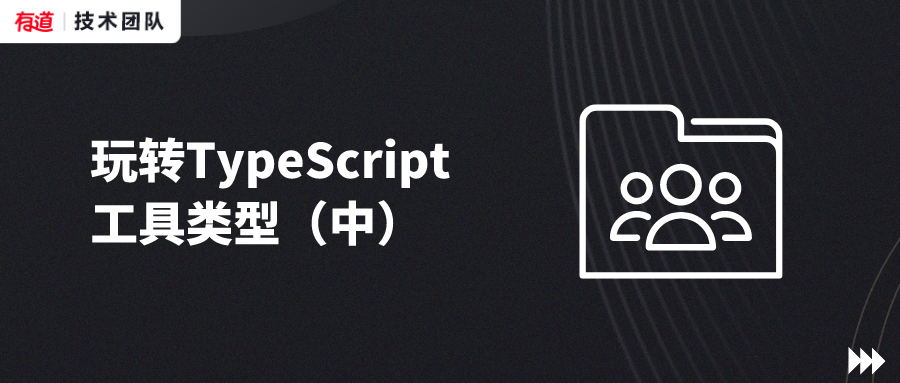联系我们:有道技术团队助手:ydtech01 / 邮箱:ydtech@rd.netease.com
本文是《玩转 TypeScript 工具类型》系列的第二篇,包含了如下几部分内容:
一. 必读:extends 条件运算符
因为后续的源码中涉及到了 extends 关键字,所以需要先提前掌握这部分内容才能更好更容易的理解源码。可以参考[[译]TypeScript条件类型],英语好的同学推荐直接看原文。
二. Exclude<Type, ExcludeUnion>:排除
将 ExcludeUnion 联合类型的所有成员从 Type 中排除,可以理解为取差集。剩余的部分返回作为一个新类型。
2.1 源码解读
type Exclude<T, U> = T extends U ? never : T;
复制代码
如何理解 T extends U ? never : T 呢?判断 T 中的每一项是否可以赋值给类型 U,如果可以,就返回 never,如果不可以,就返回当前这项。
接下来我们结合一个具体的例子来理解一下这句话。
2.2 实战用法
// 排除一个具体的值
type T0 = Exclude<"a" | "b" | "c", "a"> // "b" | "c"
// 排除一种类型
type T1 = Exclude<string | number | (() => void), Function>
复制代码
以 T0 为例,extends 关键字是如何发挥作用的呢?
type T0 = Exclude<"a" | "b" | "c", "a"> // "b" | "c"
// 等价于
type T0 = "a" extends "a" ? never : "a"
| "b" extends "a" ? never : "b"
| "c" extends "a" ? never : "c"
// 等价于
type T0 = never | "b" | "c"
// 等价于
type T0 = "b" | "c"
复制代码
如果无法理解这里的等价逻辑,建议阅读开头推荐的[[译]TypeScript条件类型]
三. Extract<Type, Union>:提取
选取 Type 类型和 Union 类型两者的公共部分并返回为一个新类型,可以理解为取交集。
3.1 源码解析
/**
* Extract from T those types that are assignable to U
*/
type Extract<T, U> = T extends U ? T : never;
复制代码
提取出类型 T 中那些能赋值给类型 U 的类型。所以这里源码上和 Exclude 的区别就在于 never 放在了条件运算结果为 false 的分支上。
所以如果理解了 Exclude ,再理解 Extract 就不复杂了。
3.2 实战用法
// 提取一个具体的值
type T0 = Extract<"a" | "b" | "c", "a"> // "b" | "c"
// 提取一种类型
type T1 = Extract<string | number | (() => void), Function>
复制代码
这里就不再重复说明 extends 的处理逻辑了。
四. NonNullable<Type>
过滤掉 Type 中的 null 和 undefined,剩余的类型作为一个新类型返回。其实就是 Exclude 的一种特殊情况。
4.1 源码解析
type NonNullable<T> = T extends null | undefined ? never : T
复制代码
可以发现和 Exclude<T, U> 的源码非常像,只是把 U 换成了 null | undefined 。所以结合 Exclude<T, U> 还是很好理解的。
4.2 实战用法
type T0 = NonNullable<string | number | undefined>;
// type T0 = string | number
type T1 = NonNullable<string[] | null | undefined>;
// type T1 = string[]
复制代码
五. 必读:tuple type 元组类型
元组类型就是一个具有固定数量元素和元素类型都确定的数组类型。
Tuple types allow you to express an array with a fixed number of elements whose types are known, but need not be the same.
例如这就是一个元组类型:
当我们访问已声明类型的元素时,可以获得正确的类型检查:
// OK
console.log(x[0].substring(1));
// Property 'substring' does not exist on type 'number'.
console.log(x[1].substring(1));
复制代码
当我们访问超出数组长度的下标时,获得的类型都是 undefined ,并且会获得一个访问下标无可访问元素的错误提示:
let x: [string, number];
x = ["hello", 10]; // OK
// Type '"world"' is not assignable to type 'undefined'.
// Tuple type '[string, number]' of length '2' has no element at index '3'.
x[3] = "world";
// Object is possibly 'undefined'.
// Tuple type '[string, number]' of length '2' has no element at index '5'.
console.log(x[5].toString());
复制代码
六. Parameters<Type>
基于一个函数参数的类型构造一个元组类型(tuple type)。所以这个工具类型的作用就是获取函数参数的类型。
6.1 源码解析
/**
* Obtain the parameters of a function type in a tuple
*/
type Parameters<T extends (...args: any) => any> = T extends (...args: infer P) => any ? P : never;
复制代码
源码中重点有两部分:
T extends (...args: any) => any ,规定了 T 必须是一个函数( any 和 never 除外),参数是 any 类型,所以参数可以是任意类型。
T extends (...args: infer P) => any ? P : never,如果 T 是函数类型,那么这个 extends 走的就是 true 分支,也就是返回一个 P 类型,而这个 P 类型就是参数 args 的类型
如果对 infe 无法理解的同学可以再回顾一下
6.2 实战用法
declare function f1(arg: { a: number; b: string }): void;
type T0 = Parameters<() => string>;
// type T0 = []
type T1 = Parameters<(s: string) => void>;
// type T1 = [s: string]
type T2 = Parameters<<T>(arg: T) => T>;
// type T2 = [arg: unknown]
type T3 = Parameters<typeof f1>;
// type T3 = [arg: { a: number; b: string; }]
type T4 = Parameters<any>;
// type T4 = unknown[]
type T5 = Parameters<never>;
// type T5 = never
type T6 = Parameters<string>;
// Type 'string' does not satisfy the constraint '(...args: any) => any'.
type T7 = Parameters<Function>;
// Type 'Function' does not satisfy the constraint '(...args: any) => any'.
// Type 'Function' provides no match for the signature '(...args: any): any'.
复制代码
这里需要关注一下 Parameters 传入 never 和 any 的情况,知道即可。
七. ConstructorParameters<Type>
把构造函数的参数类型作为一个元组类型返回。我们已经知道如何获取一个函数的参数类型,即[Parameters](# 9. )。那么如果我们要获取构造函数的参数类型,那么首先先要判断出哪一个是构造函数,然后获取参数类型即可,思路是这么个思路,那么应该怎么实现呢?
7.1 源码解析
/**
* Obtain the parameters of a constructor function type in a tuple
*/
type ConstructorParameters<T extends abstract new (...args: any) => any> = T extends abstract new (...args: infer P) => any ? P : never;
复制代码
这里有两个需要关注的点:
所以,ConstructorParameters 工具类型只是针对抽象类来发挥效果的,never 和 any 我们不需要关心。
7.2 实战用法
这里结合一个具体的例子,深入了解一下,就以 ErrorConstructor 为例:
interface ErrorConstructor {
new(message?: string): Error;
(message?: string): Error;
readonly prototype: Error;
}
type T0 = ConstructorParameters<ErrorConstructor>;
复制代码
这里 ConstructorParameters 是如何处理的呢?其实就是对 ErrorConstructor 的三条属性逐一代入 T extends abstract new (...args: infer P) => any ? P : never; ,满足条件的就返回参数类型 P。
八. ReturnType<Type>
获取函数的返回值类型。结合我们在[Parameters](# 10. )获取函数参数类型的实现,可以很容易的自己实现出这个工具类型。
8.1 源码解析
/**
* Obtain the return type of a function type
*/
type ReturnType<T extends (...args: any) => any> = T extends (...args: any) => infer R ? R : any;
复制代码
和 Parameters<Type> 实现的唯一的区别就是 infer 的位置从参数位置跑到了返回值位置。这还是很好理解的。
注意返回值类型不是元组类型,因为在 Parameters<Type> 中,args 是一个数组,所以返回的是一个元组类型,而函数的返回值可以是任意类型的。
8.2 实战用法
declare function f1(): { a: number; b: string };
type T0 = ReturnType<() => string>;
// type T0 = string
type T1 = ReturnType<(s: string) => void>;
// type T1 = void
type T2 = ReturnType<<T>() => T>;
// type T2 = unknown
type T3 = ReturnType<<T extends U, U extends number[]>() => T>;
// type T3 = number[]
type T4 = ReturnType<typeof f1>;
// type T4 = {a: number;b: string;}
type T5 = ReturnType<any>;
// type T5 = any
type T6 = ReturnType<never>;
// type T6 = never
type T7 = ReturnType<string>;
// 类型“string”不满足约束“(...args: any) => any”。ts(2344)
type T8 = ReturnType<Function>;
// 类型“Function”不满足约束“(...args: any) => any”。
// 类型“Function”提供的内容与签名“(...args: any): any”不匹配。ts(2344)
复制代码
九. InstanceType<Type>
获取构造函数实例的返回类型。也就是对构造函数调用new操作符后的返回值类型。我们已经知道了如何获取构造函数参数的类型,所以很方便的就可以推导出如何获取实例的类型。
9.1 源码解析
/**
* Obtain the return type of a constructor function type
*/
type InstanceType<T extends abstract new (...args: any) => any> = T extends abstract new (...args: any) => infer R ? R : any;
复制代码
也是把 infer 的位置从参数位置移到了返回值位置。
9.2 实战用法
这里我们继续以 FunctionConstructor 为例:
interface FunctionConstructor {
/**
* Creates a new function.
* @param args A list of arguments the function accepts.
*/
new(...args: string[]): Function;
(...args: string[]): Function;
readonly prototype: Function;
}
type T0 = InstanceType<FunctionConstructor>;
复制代码
结合 new(...args: string[]): Function; 可知:
更多情况可以在 typescript playground 中自己尝试一下。
十. 下回预告
在下一篇《玩转 TypeScript 工具类型(下)》里,将会包括如下内容,敬请期待:
ThisParameterType<Type>
OmitThisParameter<Type>
ThisType<Type>
快捷跳转














评论